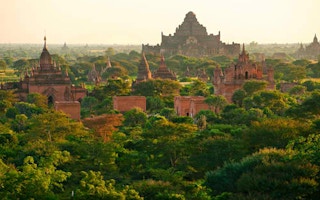It is still home to some of the most pristine forests in Southeast Asia. But forest experts warn that Myanmar is fast losing its woodlands due to a combination of commercial logging, agricultural expansion and firewood harvesting.
According to the UN-REDD Programme, at least half of Myammar’s land of 667,000 square kilometres is still covered in forest. But the country also has suffered an alarmingly high rate of deforestation. The UN–REDD Programme estimates that in the 15 years between 1990 and 2005, the country lost 18 per cent of its forests, and the deforestation rate may have since increased.
The World Wildlife Fund (WWF), looking at a somewhat longer period, estimates that Myanmar lost more than half of its dense forest cover between 1990 and 2010, with the area covered by forest falling from 45 per cent to around 20 per cent.
What the leading cause of the deforestation is depends on who you ask.
“Harvesting for fuel wood and charcoal is by far the largest component of wood removals in Myanmar,” said Michelle Owen, WWF’s conservation programme manager in Myanmar. The country’s highest deforestation rates have been recorded from the Ayeyarwady Delta as a result of firewood extraction for Yangon, the country’s largest city.
“
The main deforestation threat has been, since the 1990s, logging by companies connected to the military. This continues today during the reform period
Kevin Woods, author of a report on Myanmar’s timber trade
But logging for timber exports poses an equally powerful threat, some researchers say. “The main deforestation threat has been, since the 1990s, logging by companies connected to the military. This continues today during the reform period,” said Kevin Woods, author of a report on Myanmar’s timber trade.
Woods said that a more recent development has been clearing of forest land for agriculture use and selling the timber.
Porous borders
Woods’ research has shown that despite bans by the government, considerable amounts of timber were moved across Myanmar’s porous borders, especially in areas where there is armed conflict. The researcher also said that the simplistic procedure adopted to authenticate timber exports from Myanmar allowed for manipulation of the timber’s true origins.
All exports are validated as legal if they have the stamp of the Myanmar Timber Enterprise (MTE), under the Ministry of Environmental Conservation and Forests (MOECAF), and are shipped out of Yangon.
“It is therefore crucial to disentangle the various chains of custody in order to better gauge the degree to which Myanmar wood can be considered legal, sustainable and ethical, and the land rights regimes operating from sourced areas,” Woods said in his paper.
Woods said there was barely any restriction on the number of timber certificates issued or the tonnage that could be exported. WWF’s Owen said that limits set by the government on timber harvesting are exceeded due to export revenue targets set by the Myanmar Timber Enterprise.
“Over the past decade or more, these practices have resulted in MTE and private logging companies exceeding the annual logging quota by a significant amount,” she said.
For the 2013-14, the government set a target of 186,650 cubic meters of teak exports. However Owen said that by the end of the fiscal year, the total exports were over 400,000 cubic meters.
Woods said that there were encouraging signals coming from the government, such as the implementation of a total ban on exporting unprocessed timber starting in April 2014, and a lowered quota for timber clearing. But the effectiveness of such plans was yet unclear, he said.
At least one of the proposed government schemes has had the opposite impact of what was intended. The impending ban on exports of unprocessed timber has seen an increase in exports in the last six months according to the Myanmar Timber Merchants’ Association.
Bar Bar Cho, an official from the association, said that timber exports were likely to record an increase of 30 percent in 2014 primarily because exporters were rushing to beat the ban.
“Export earnings, which are in the region of $600 million to $800 million annually are likely to top $1 billion this year,” he said.
WWF’s Owen warned that with the country opening up for foreign investments, the pressure on the forests was likely to increase.
“It is fair to assume that increasing exposure to global commodity markets, coupled with rapid (foreign direct investment) inflows and a weak governance environment, will lead to direct deforestation for (large-scale agriculture) and indirect deforestation caused by (large-scale agriculture) displacing poor farmers to the forest margins where they have to clear new land.”










